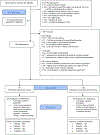Effect of the Telemedicine Enhanced Asthma Management Through the Emergency Department (TEAM-ED) Program on Asthma Morbidity: A Randomized Controlled Trial
- PMID: 38065280
- PMCID: PMC10922928
- DOI: 10.1016/j.jpeds.2023.113867
Effect of the Telemedicine Enhanced Asthma Management Through the Emergency Department (TEAM-ED) Program on Asthma Morbidity: A Randomized Controlled Trial
Abstract
Objective: To test the effectiveness of a telemedicine-based program in reducing asthma morbidity among children who present to the emergency department (ED) for asthma, by facilitating primary care follow-up and promoting delivery of guideline-based care.
Study design: We included children (3-12 years of age) with persistent asthma who presented to the ED for asthma, who were then randomly assigned to Telemedicine Enhanced Asthma Management through the Emergency Department (TEAM-ED) or enhanced usual care. TEAM-ED included (1) school-based telemedicine follow-ups, completed by a primary care provider, (2) point-of-care prompting to promote guideline-based care, and 3) an opportunity for 2 additional telemedicine follow-ups. The primary outcome was the mean number of symptom-free days (SFDs) over 2 weeks at 3, 6, 9, and 12 months.
Results: We included 373 children from 2016 through 2021 (participation rate 68%; 54% Black, 32% Hispanic, 77% public insurance; mean age, 6.4 years). Demographic characteristics and asthma severity were similar between groups at baseline. Most (91%) TEAM-ED children had ≥1 telemedicine visit and 41% completed 3 visits. At 3 months, caregivers of children in TEAM-ED reported more follow-up visits (66% vs 48%; aOR, 2.07; 95% CI, 1.28-3.33), preventive asthma medication actions (90% vs 79%; aOR, 3.28; 95% CI, 1.56-6.89), and use of a preventive medication (82% vs 69%; aOR, 2.716; 95% CI, 1.45-5.08), compared with enhanced usual care. There was no difference between groups in medication adherence or asthma morbidity. When only prepandemic data were included, there was greater improvement in SFDs over time for children in TEAM-ED vs enhanced usual care.
Conclusions: TEAM-ED significantly improved follow-up and preventive care after an ED visit for asthma. We also saw improved SFDs with prepandemic data. The lack of overall improvement in morbidity and adherence indicates the need for additional ongoing management support.
Trial registration: NCT02752165.
Keywords: asthma; child; emergency department; prevention; telemedicine.
Copyright © 2023 Elsevier Inc. All rights reserved.
Conflict of interest statement
Declaration of Competing Interest The authors declare no conflicts of interest. Funded by a grant from the National Heart, Lung, and Blood Institute of the National Institutes of Health (R01HL091835). The funder had no role in the study design, data collection, data analysis, data interpretation, or writing of the report.
Figures



Similar articles
-
Effect of the School-Based Telemedicine Enhanced Asthma Management (SB-TEAM) Program on Asthma Morbidity: A Randomized Clinical Trial.JAMA Pediatr. 2018 Mar 5;172(3):e174938. doi: 10.1001/jamapediatrics.2017.4938. Epub 2018 Mar 5. JAMA Pediatr. 2018. PMID: 29309483 Free PMC article. Clinical Trial.
-
Prompting asthma intervention in Rochester-uniting parents and providers (PAIR-UP): a randomized trial.JAMA Pediatr. 2014 Oct;168(10):e141983. doi: 10.1001/jamapediatrics.2014.1983. Epub 2014 Oct 6. JAMA Pediatr. 2014. PMID: 25288141 Free PMC article. Clinical Trial.
-
Utilization of the emergency department as a routine source of care among children with asthma.J Asthma. 2023 Jul;60(7):1377-1385. doi: 10.1080/02770903.2022.2149409. Epub 2022 Dec 12. J Asthma. 2023. PMID: 36399630 Free PMC article.
-
Does a Stress Management Program for African American Parents Increase Asthma Symptom–Free Days for Their Children? The BEAMS Study [Internet].Washington (DC): Patient-Centered Outcomes Research Institute (PCORI); 2020 Apr. Washington (DC): Patient-Centered Outcomes Research Institute (PCORI); 2020 Apr. PMID: 40043157 Free Books & Documents. Review.
-
School-based self-management interventions for asthma in children and adolescents: a mixed methods systematic review.Cochrane Database Syst Rev. 2019 Jan 28;1(1):CD011651. doi: 10.1002/14651858.CD011651.pub2. Cochrane Database Syst Rev. 2019. PMID: 30687940 Free PMC article.
Cited by
-
The effects of different follow-up management on asthma control: a prospective cohort study.BMC Pulm Med. 2025 Jul 4;25(1):327. doi: 10.1186/s12890-025-03771-1. BMC Pulm Med. 2025. PMID: 40615808 Free PMC article.
-
Optimizing adherence to medication to improve outcomes in asthma.Curr Opin Pulm Med. 2025 May 1;31(3):262-269. doi: 10.1097/MCP.0000000000001166. Epub 2025 Mar 19. Curr Opin Pulm Med. 2025. PMID: 40105049 Free PMC article. Review.
References
-
- Expert Panel Working Group of the National Heart, Lung, and Blood Institute (NHLBI) administered and coordinated National Asthma Education and Prevention Program Coordinating Committee (NAEPPCC); Cloutier MM, Baptist AP, Blake KV, Brooks EG, Bryant-Stephens T, DiMango E. 2020 Focused Updates to the Asthma Management Guidelines: A Report from the National Asthma Education and Prevention Program Coordinating Committee Expert Panel Working Group. J Allergy Clin Immunol. 2020. Dec;146(6):1217–1270. - PMC - PubMed
-
- Chipps BE, Murphy KR, Oppenheimer J. 2020 NAEPP Guidelines Update and GINA 2021-Asthma Care Differences, Overlap, and Challenges. The journal of allergy and clinical immunology In practice. 2022;10(1S):S19–S30. - PubMed
-
- Teach SJ, Crain EF, Quint DM, Hylan ML, Joseph JG. Improved asthma outcomes in a high-morbidity pediatric population: results of an emergency department-based randomized clinical trial. Arch Pediatr Adolesc Med. 2006;160(5):535–41. - PubMed
-
- National Asthma Education and Prevention Program (NAEPP). Expert Panel Report 3 (EPR-3): Guidelines for the Diagnosis and Management of Asthma-Summary Report 2007. J Allergy Clin Immunol. 2007;120(5 Suppl):S94–138. - PubMed
-
- Li P, To T, Guttmann A. Follow-up care after an emergency department visit for asthma and subsequent healthcare utilization in a universal-access healthcare system. J Pediatr. 2012;161(2):208–13 e1. - PubMed

